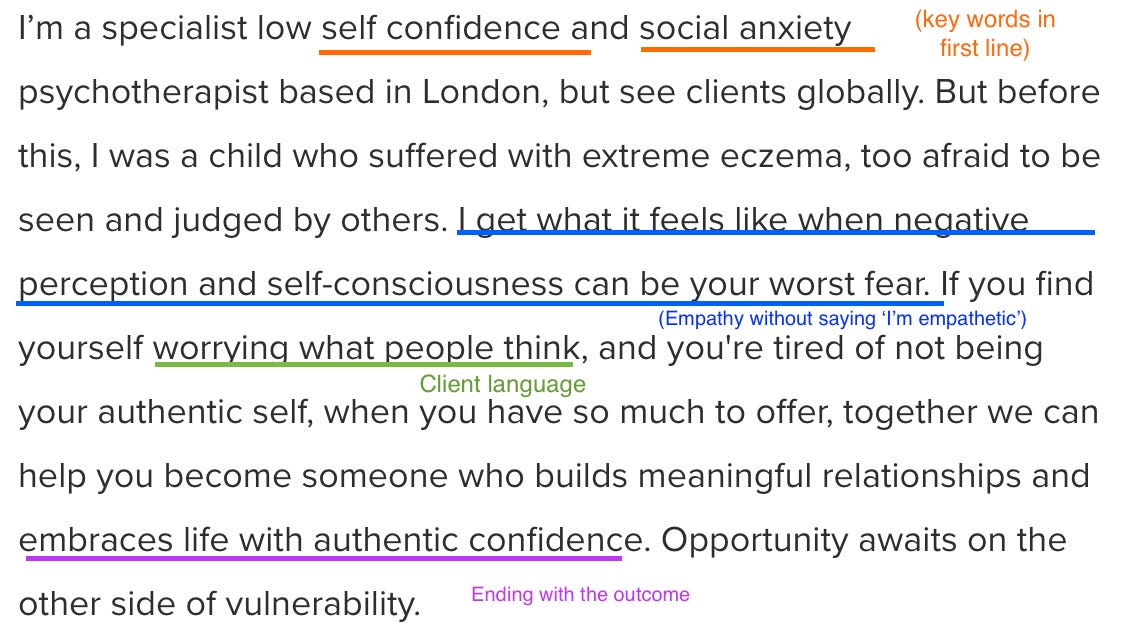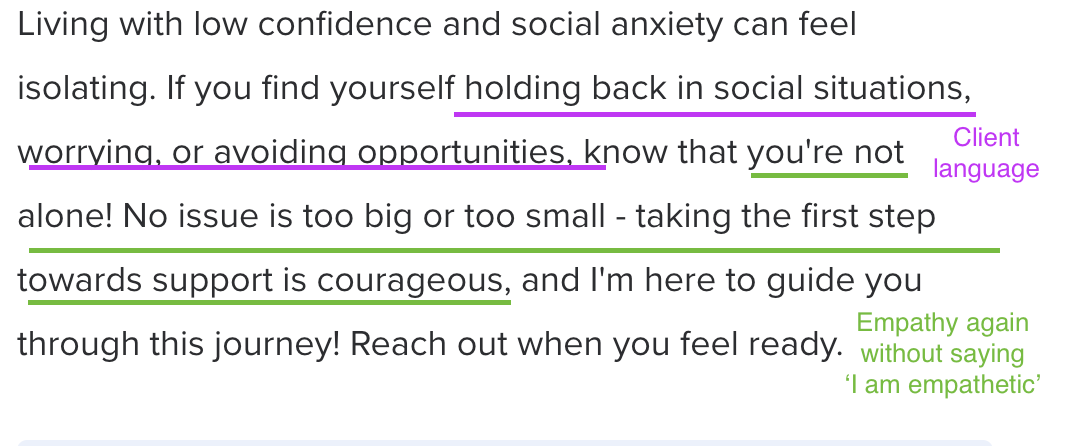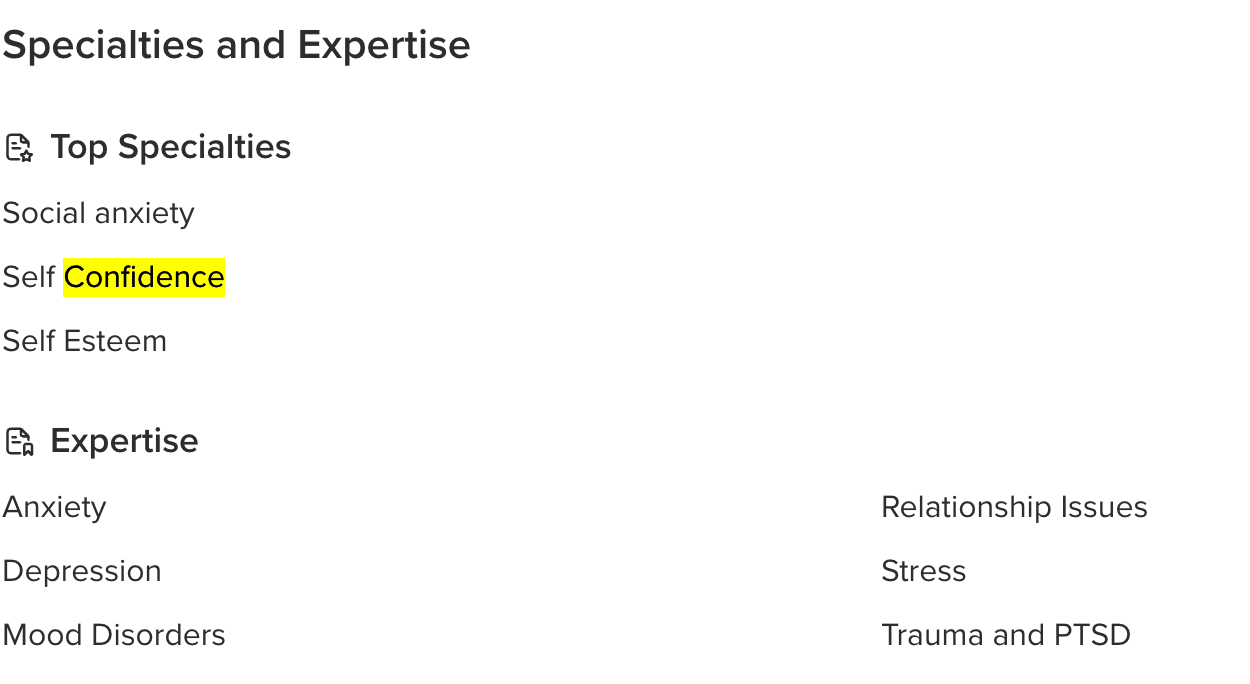How I Optimised My Psychology Today Profile to Rank on Google (And How You Can Too)
From a quiet directory listing to your primary referral source straight from Google: simple tweaks that transform your directory profile to keep referrals coming steadily.
Most therapists I speak with have a Psychology Today profile, but few realise its true potential and therefore only see minimal results.
When I set up my profile after qualifying as a CBT therapist, I approached it not just as a directory listing but as a powerful SEO asset. The result?
My profile now appears on the first page of Google searches for therapists in my area, generating a steady stream of appropriate client inquiries.

Why Your Psychology Today Profile Matters More Than You Think
Before we dive into optimisation techniques, let's understand why Psychology Today (PT) profiles carry so much weight:
1. Domain authority
Psychology Today has high domain authority (a metric that predicts how well a site will rank in search results). This means Google trusts content from Psychology Today more than it would trust the same content on your personal website.
This is why your psychology today profile can show on Google much quicker and easier, than your website can.
2. Geolocation advantages
Psych today profiles are structured in a way that makes them particularly effective for local searches like "CBT therapist in [your city]."
3. Verification signals
Being listed in a recognised directory sends trust signals to both search engines and potential clients, particularly as psychology today audits qualifications.
The Return on Investment of My Optimised Profile
When I first qualified, I invested two full hours in perfecting my Psychology Today profile. The return on that investment has been:
My profile appears on the first page of Google results for my target keywords
Clients arrive at sessions having already resonated with my approach
My conversion rate from inquiry to booking is nearly twice as high with Psych Today leads compared to when I had a generic profile
My Step-by-Step Optimisation Process
1. Strategic Headline Crafting
Your headline is arguably the most important element of your profile. Most therapists make the mistake of being too generic (Just your name or "Accredited Therapist") or listing too many specialties ("Anxiety, Depression, Trauma, Relationships, Grief, Life Transitions..."). You can’t be a specialist in everything.
I took a specialised approach:
What I did: Created a headline that combined my niche specialisation with a client outcome.
Example: "Sophia - Social Anxiety & Confidence Specialist"
This headline:
Contains searchable keywords (Social Anxiety, Confidence)
Speaks directly to my ideal client
Focuses on specific problems I see (social anxiety) and outcome (confidence)
Differentiates me from general practitioners who are just listed by name
2. Photo Optimisation
Your profile photo isn't just about looking professional—it's about creating an immediate connection.
What I did: Used a high-resolution, authentic photo that conveyed warmth and confidence.
Beyond just image quality, I:
Used a simple, non-distracting background
Opted for a slight smile rather than a full grin or serious expression
Had the photo sort-of professionally taken (I had it taken for the sole purpose of professional headshot but not by a professional!) but in a natural, approachable style
Do not use a selfie
You don’t need to pay for professional photos. Getting a friend to take a headshot of you on their iPhone is enough - it’s the style of the photo that is most important as long as it meets a basic quality.
3. About Section SEO Enhancement
The "About" section needs to serve two key purposes: search engines (for SEO - search engine optimisation) and potential clients. This is the most important section. Clients can find you directly from Google if this is done correctly.
What I did: Structured my about section with both SEO and readability in mind.
I included:
My primary keywords in the first 50 words (social anxiety, confidence)
Short, scannable paragraphs (no more than 3-4 sentences each)
Bullet points to break up text
A clear problem-solution format
Location references naturally woven into the text
Language mirroring how clients describe their problems
Key insight: I researched how my ideal clients described their challenges in forums (reddit is a goldmine for this - see section below on Client Awareness levels for more), then incorporated that exact language into my profile.
For example:
Social Anxiety in client terms becomes worrying what people think.
Safety Behaviours in client terms becomes not being your authentic self or performing to be accepted.
I hope above is helpful! If you want to see exactly how I structured my About section for maximum impact, in the premium content below, I share:
My exact Psychology Today About section template with annotations explaining the psychology behind each part
My method for identifying exactly how your ideal clients describe their challenges
How many times keywords are in my profile and where
Subscribe now to unlock these resources and transform your Psychology Today profile into a client-generating powerhouse!
Here’s my intro:
By interweaving key words, client language, and empathetic statements, your introduction becomes optimised for Google, whilst speaking directly to your client.
4. Specialties and Treatment Approach Sections
The specialties section is more than just a checklist—it's an opportunity to rank for specific search terms.
What I did: Prioritised depth in a few specialties rather than breadth across many.
Instead of checking every box that remotely applied to my practice, I:
Selected 5-7 core specialties where I have genuine expertise (social anxiety, confidence, low self esteem)
Listed my primary specialisation first
Included related issues that my ideal clients might search for (e.g. relationship issues)
Having a few relevant specialisms helps create authority in your approach. A specialist in everything, unfortunately from a marketing perspective, is a specialist in nothing.
Whilst I know that you’re likely an amazing therapist with a range of diagnoses, unfortunately for marketing, it can be hard to then stand out in the (very busy) crowd.
For the treatment approach section, I:
Selected Cognitive Behavioural Therapy as my primary approach
Limited secondary approaches to those that genuinely inform my practice
Added a brief explanation of how I integrate approaches for client benefit
5. Location Optimisation
Many therapists underestimate the importance of the location section, especially now that seeing clients across the country/world via videocall is common.
What I did: Optimised for both physical and virtual presence.
Specifically, I:
Listed my exact office address in London for local SEO benefits
Added surrounding areas and neighbourhoods in my "serves" section
Included that I see people remotely anywhere
Referenced my location naturally throughout my profile text
6. Client Focus Precision
The client focus section helps both your SEO relevance and attracts the right clients.
What I did: Got specific about who I work with best.
Rather than trying to appeal to everyone, I:
Selected specific age ranges where I have the most experience
Specialist in one diagnosis and a few other relevant diagnoses
7. Strategic Use of Keywords
Keywords need to be incorporated naturally and regularly throughout your profile.
What I did: Distributed relevant keywords strategically across all sections.
I researched and included:
Location-based terms (city, neighbourhood, region)
Therapy type (CBT, cognitive behavioural therapy)
Professional terminology that clients might search for (social anxiety)
Layperson's terms for the same concepts
My profile says social anxiety 16 times and confidence 18 times.
Repetition of your key words is key for Google to pick them up.
Understanding Client Awareness Levels in Your Keyword Strategy
One of the most overlooked aspects of profile optimisation is understanding the varying levels of client awareness.
Many therapists make the critical mistake of only using clinical terminology that matches their diagnosis framework rather than the language clients actually use to describe their experiences.
For example, a client struggling with undiagnosed PTSD isn't searching for "PTSD treatment" - they're searching for "help with nightmares" or "why do I feel jumpy all the time?"
But a client with diagnosed PTSD is probably searching for “ptsd therapist'“.
Similarly, someone with high-functioning anxiety might search "why can't I relax" rather than "anxiety therapist."
But a client who understands their anxiety, will likely search for “specialist anxiety therapist”.
In my profile, I deliberately included symptom-based language (e.g. self consciousness, low confidence) alongside clinical terms, which dramatically increased my visibility to clients in the early stages of recognising their challenges.
By mapping out the full awareness spectrum - from problem recognition ("why do I feel this way?") to solution awareness ("I need CBT for social anxiety") - I was able to capture potential clients at every stage of their help-seeking journey.
You can find how your clients describe their difficulties by simply going on the reddit forum for the appropriate difficulty.
You will see valuable information about how clients actually talk about their difficulties. I’ve listed the links for common ones below, but there are 1000s. Just Google search ‘Reddit [your difficulty]’ and it’ll come up if it exists!
Reddit Forums
8. Building Profile Authority
Psychology Today profiles, like websites, gain authority over time through engagement.
What I did: Implemented strategies to increase my profile's authority.
These included:
Updating my profile quarterly with fresh content
Endorsing other therapists and receiving endorsements back
Ensuring consistent information across my PT profile and other online listings
Link to my psychology today profile from my website
The Results: From Invisible to First Page
Within three months of implementing these optimisation strategies, my Psychology Today profile moved from floating around the internet to page one of Google results for my target keywords.
More importantly, the quality of client inquiries improved dramatically—most were already on-board with my pricing and aligned with my niche.
Note: I don’t like to pretend anything is a quick fix. Whilst these changes ensured greater reach, a higher rank in Google and more referrals, my price is still premium and therefore not all enquiries translate into bookings. I am ok with this as I know my price point is higher, but I like to put a disclaimer that there is no silver bullet solution when it comes to private practice! The majority of my client bookings still come directly from my website, but these changes significantly increased my psych today reach and referrals.
Common Mistakes to Avoid
Based on my experience and observation of other therapists' profiles, here are the pitfalls to avoid:
1. Therapist-centered language
Focus on the client's experience and problems rather than your credentials and background.
2. Generic descriptions
"I provide a safe space for healing" appears on thousands of profiles. Be specific about your approach. You can also assume that most clients think therapists will be empathetic and understanding. Don’t waste too much space on this, talk about what else you add or show empathy in what you write!
3. Keyword stuffing
While keywords matter, forced or unnatural keyword usage will drive potential clients away. Place them where you can but do not over-do it.
4. Inconsistent information
Ensure your contact information, specialties, and approach match across all your online platforms. Having an instagram that says body image specialist but your psychology today is general, suggests a lack of true specialism.
5. Outdated information
Set a calendar reminder to review your profile quarterly, updating any changes to your practice.
Your Psychology Today Optimisation Checklist
Ready to optimise your own PT profile? Here's a quick checklist to get started:
Craft a headline that combines specialty + outcome
Update your photo to convey warmth and professionalism
Rewrite your "About" section using client centred language - thinking about stages of awareness and key words
Optimise your location information for local searches
Define your client focus areas with precision
Distribute keywords naturally throughout all sections
Schedule quarterly reviews and updates
Final Thoughts: Your Digital First Impression
Your Psychology Today profile is often the first impression potential clients have of you and your practice. By optimising it thoughtfully, you're not just improving your search rankings—you're ensuring that the right clients can find you at the moment they're ready for help.
The time investment is minimal compared to the potential return: a steady stream of ideal clients who already resonate with your approach before they even reach out.
Remember, in a sea of similar profiles, specificity and authenticity are your greatest differentiators.
Don't try to appeal to everyone—focus on connecting deeply with the clients you can help most.
Note: This is general advice and is to be taken with a pinch of salt! You do not need to niche down to a diagnosis. Perhaps you are a niche therapist, or perhaps your niche is a client group (e.g. postnatal mums but you see all diagnoses). Or, perhaps there aren’t many therapists that offer your specific therapy modality, or not many therapists in your location. All of these things would mean you do not need to necessarily niche to a diagnosis. The main point is to make sure you have a repeated key word that Google can pick up that speaks to the clients you want to attract. Take the advice above which is helpful, and disregard or adapt the bits that don’t necessarily apply to you!
Have questions about optimising your Psychology Today profile? Reply to this newsletter! I'd love to hear about your experience!








This post should have more likes - definitely did the trick on my profile already! Thank you, you’re a gem.